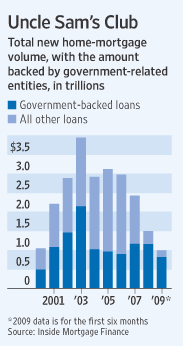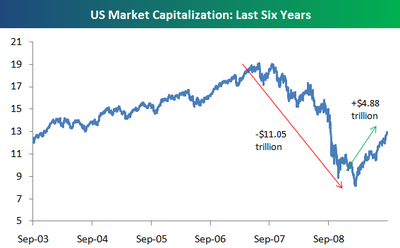NOTE: Every week I write a Client Note for my clients. For a limited time, I am allowing non-clients to sign up and receive the Client Note. You can sign up at the top right hand corner of the website. Here is this week’s.
*****
I must state at the outset that I am in fundamental disagreement with the prevailing wisdom. The generally accepted theory is that financial markets tend towards equilibrium, and on the whole, discount the future correctly. I operate using a different theory, according to which financial markets cannot possibly discount the future correctly because they do not merely discount the future; they help to shape it. In certain circumstances, financial markets can affect the so called fundamentals which they are supposed to reflect. When that happens, markets enter into a state of dynamic disequilibrium and behave quite differently from what would be considered normal by any theory of efficient markets.. Such boom/bust sequences do not arise very often, but when they do, they can be very disruptive, exactly because they affect the fundamentals of the economy.
It was a period of tremendous experimentation. When you’re faced with a crisis of this magnitude, if you take the view that every measure that we take has to be exactly right, you don’t do anything.
We’re propping up the market with so much liquidity right now that it has no other place to go but up. You can almost throw out the other fundamentals, which tell you the market should be looking overbought. The reality is, the money has to go somewhere.
– Howard Simons, Bianco Research, quoted in The Wall Street Journal Online, September 22
I have been wracking my brain and doing some soul searching over the last couple of weeks trying to figure out what, if anything, I might have gotten wrong or missed. This rally has surprised me in its strength and duration and I’ve been wrong time and again in predicting its imminent demise.
My daily comprehensive surveys of economic and financial reports, print and online media, and blogs, persuaded me that the fundamentals did not support a new bull market. Hence, it had to be a bear market rally that would end at some point, though the exact timing is always elusive.
Within the last week, however, new understandings and integrations have made the powerful character of the rally intelligible and comprehensible to me. To state it succinctly: The barrage of government programs has worked in putting a floor under the economy – for now.
*****
These new insights started last Thursday as I read a shocking front page
Wall Street Journal article detailing the governments massive subsidization of the housing and mortgage markets:
“No Easy Exit For Government as Housing Market’s Savior”,
The Wall Street Journal, September 15, A1. Put together the nationalization of Fannie Mae and Freddie Mac, a 0% Fed Funds rate, Fed purchases of $1.5 trillion in Fannie and Freddie debt and mortgage backed securities, the growth of The Federal Home Administration and Ginnie Mae in guaranteeing mortgages and the $8,000 first time home buyer credit, and it’s no wonder that home prices have stabilized and bottomed. Of course they have! With all this stimulus, the Feds might even be creating a new, artificial, boom.

Remember that it’s been the housing market that has driven the entire bust. Not only has it hurt the wealth of homeowners and cost the income and jobs of many in the real estate business, but it has destroyed the banks. It was the blowup of the financial system as a result of the housing bust that brought down the stock market last year.
But with all the Federal programs and subsidies seeming to have worked in putting a floor under the housing market, many of these problems are alleviated and start to go away. Stable house prices means owners with onerous, adjustable rate mortgages can start to think about refinancing. There are buyers because of all the Federal mortgage programs combined with low prices and the $8,000 first time buyer tax credit. In fact, according to the WSJ piece, the Federal government now provides some form of support to more than 80% of all residential mortgages. This generates activity and jobs in the real estate business.
On the mortgage side, the stabilization of home prices naturally stabilizes the mortgage market. All those mortgages and mortgage backed securities increase in value as the situation of homeowners improves and the value of the underlying collateral stabilizes. Because of the secondary market for mortgages, improved pricing can be marked to bank balance sheets and improves their capital position. That also increases their ability to be active in markets and to lend.
The government bailouts and subsidies have not been limited to the housing market either. They guaranteed the $4 trillion money market market allowing these funds to buy corporate commercial paper with a government back stop. That provided money for corporations to use to fund day to day operations.
The government guaranteed bank debt resulting in $113 billion in issuance in December 2008. Of course buyers were comfortable buying this debt when it was backed by a guarantee from the federal government. All that money repaired bank balance sheets and allowed them to lend and be active in markets.
Let’s not forget about the TARP either. Many banks are paying back or talking about paying back this money. But that’s another $700 billion that was injected into the financial system. That money has go somewhere.
And that’s not an exhaustive account of the government bailouts…..
*****
The next thing to realize is that much of this new money found its way into markets. It has reflated the mortgage, credit and stock markets. And here’s the key point: the rise in these markets not only reflects improvement in the real economy but is actually one of the fundamental drivers of that improvement. Here is where George Soros’s theory of reflexivity comes into play.
Consider just the stock market for now, which is not even the most important market. In the six months since the March low, the value of the US stock market has surged by $5 trillion. The value of global stock markets has increased by $18 trillion (see
“Investors Get Back $18.31 Trillion”, BeSpoke Investment Group, September 21). US citizens and corporations are now $5 trillion wealthier than they were 6 months ago. Do you think that makes a difference in how they conduct business, the decisions they make and their credit worthiness to lenders?
Now apply that same logic to the reflation of the housing, mortgage and credit markets. Holders of all these assets are now much wealthier than they were six months ago. Individuals and corporations that were in financial trouble have in many cases been bailed out by the increase in value of their assets.
In sum, all the government programs have succeeded in stabilizing the housing market and reflating securities markets, resulting in a massive, bubble-like, increase in wealth for individuals and corporations across the United States and the entire globe. This increase in personal and corporate balance sheets has gone a long way towards repairing the damage of the bust and has a reflexive impact on the real economy.
*****
There are long term consequences to all this. We got into this mess because of easy money, excessive debt and government subsidization of the housing market. It seems strange on the face of it that more of the same would be the cure. Obviously, it isn’t. It’s analogous to a drug addict in the throes of withdrawal who can’t take it anymore and goes for a big dose. At first, he feels great, he’s back to normal, he’s cured. But, in the end, the ultimate crash is even worse than it would have been.
All this easy money literally papers over problems in the real economy at the long term cost of the soundness of our monetary unit on which the entire global economic system depends. Bernanke’s “whatever it takes” approach has worked for now, but he is gambling with our economic future in an unprecedented way.
*****
As a result of these new insights, I covered half of our short positions, which had grown rather large as the market moved against us, last week. That raised cash in the portfolio and brought our overall positioning closer to flat though we are still net short.
Even with everything I just wrote explaining and justifying the recent stock market rally, the S&P has already rallied more than 60% since early March. Much of this analysis is already discounted in the stock market. So this is no time to completely change course and put everything into stocks. The move could still be close to over or it could have more to go.
I have already determined in my mind at what levels I will cover our remaining short positions and move to the sidelines to wait for a better spot. If the market continues to move up, I will also consider speculating with a small portion of our portfolios. But this is a very speculative market and my main concern at the moment is prudence and capital preservation.
I am still trying to integrate and make sense of this new analysis and its implications for investing our portfolios. I will keep you posted on our journey as always. I am sorry we have not participated in this move to the extent all of you would have liked. But I am optimistic that I am in the process of righting the ship in the bizarre economic and financial circumstances we currently find ourselves in.
YTD Returns (through 9/18)
S&P: +18.27%
DJ Total Stock Market: +21.40%
Top Gun: +6.02%
Greg Feirman
Founder & CEO
A Registered Investment Advisor
9700 Village Center Dr. #50H
Granite Bay CA 95746
(916) 224-0113
CALL NOW FOR A FREE INITIAL CONSULTATION!


